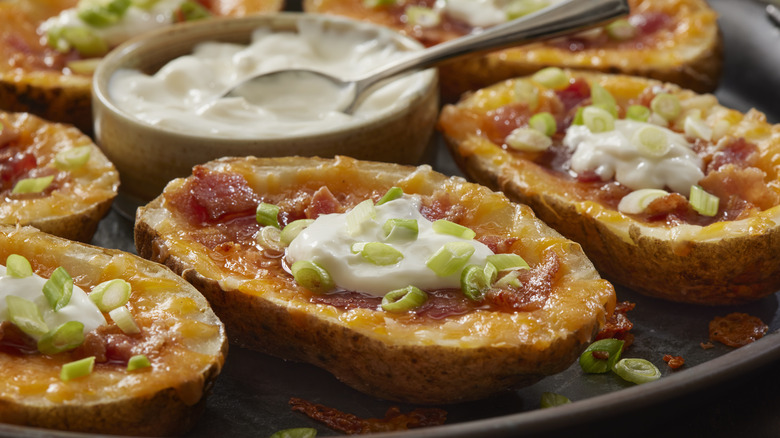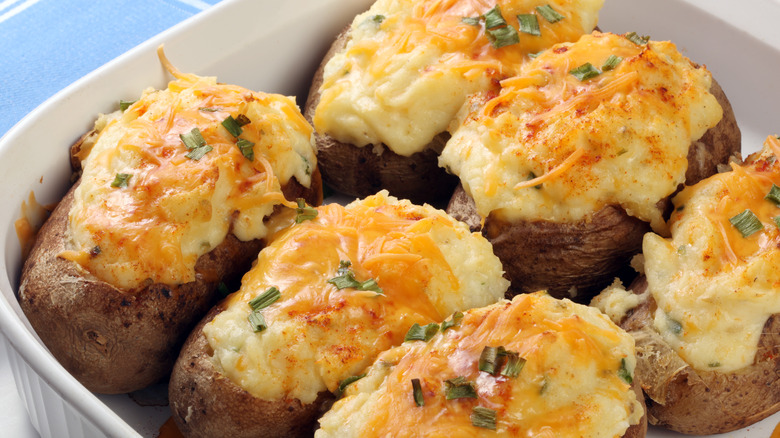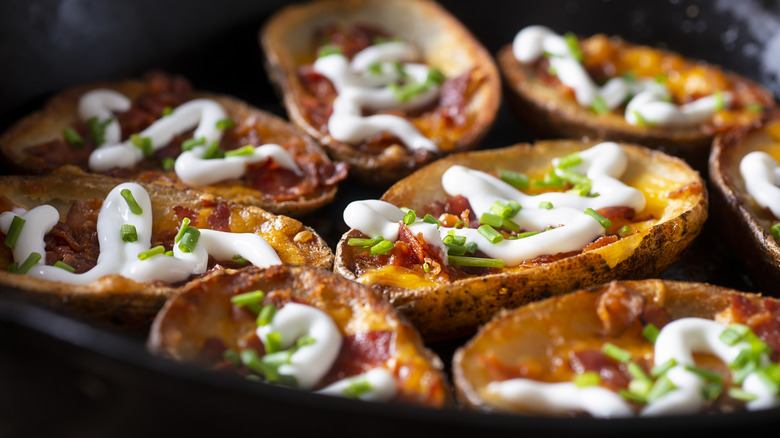What's The Actual Difference Between Twice-Baked Potatoes And Potato Skins?
If you're anything like us, you're obsessed with all things spuds. Whether we're talking about iconic styles of mashed potatoes, the different kinds of French fries, or gorging on a plate of crispy patatas bravas, sign us up for every single one. If you're looking to enjoy yet more of our favorite potato dishes, you'll have to meet the food cousins known as twice-baked potatoes and potato skins.
While they may look slightly similar, the main difference between the two is how they're cooked — and the end result. Twice-baked potatoes are a side dish made of classic baked potatoes that are fully cooked, and then they have their potato-y insides removed, mashed, and stuffed back into the skin — usually with some cheese — and baked again. The result is a creamy and rich mashed potato that's presented in its original skin.
Potato skins, on the other hand, are usually served as an appetizer. They're made of baked potatoes that have been cooked, halved, and hollowed out. Because the flesh is scooped out, this makes them perfect for stuffing with fillings like cheese, bacon bits, and scallions thanks to the extra room. The result is a super crispy skin that, while delicious, isn't too filling. This is why skins are usually a snack or starter as opposed to a side dish for a hefty T-bone or lobster tail.
What are twice-baked potatoes?
An elegant side dish that can be served with all kinds of mains — like juicy steak, grilled shrimp, or blackened chicken — the origins of twice-baked potatoes are hard to pin down, but they became popular throughout the United States in the 1960s. And with good reason — these stuffed potatoes are not only impossibly creamy, but their presentation makes them a showstopper on most tables (especially when someone gets served one for the first time).
Unlike potato skins, most people don't actually eat the skin of twice-baked potatoes (although some guests might still want to, so you'll still want to scrub each tuber really well). The best spud to use is a russet potato, thanks to its sturdy skin that holds up well to being baked multiple times, and its fluffy interior that makes for a rich and creamy mash.
While cheese is the most common topping for this dish, you can also add extra flavor by including bacon, green onions, diced ham, or even shredded beef and BBQ sauce to make a one-spud meal. If you want to get even more extra, you can even upgrade your mashed potatoes with some unique ingredients, like cream cheese, ricotta, browned butter, or even coconut milk for some vegan richness.
What are potato skins?
A classic appetizer that's popular in sports bars and can stand up to even the most impressive Super Bowl snacks, potato skins are said to have been invented in the middle of the 20th century, thanks to a restaurateur named Richard Melman. From a radio broadcast, Melman learned about sailors who ate potato skins to ward off illness (thanks to them having up to 12 times more antioxidants than the flesh alone). Inspired, he decided to play around until he came up with the potato skins we know today.
While the most common toppings for potato skins are cheese and bacon, you can find them on restaurant menus with all kinds of finishing touches, like sour cream, chives, jalapeños, and even fun variations like barbecue skins. When making this dish, russets are the variety of choice once again, thanks to their tough skins that crisp up nicely when baked.
You'll want to take extra care to really scrub the potatoes here, because your guests will be eating the entire thing. Once scrubbed and dried, cook them just as you would a typical baked potato and let them fully cool. Cut each potato in half lengthwise, scooping out the flesh and setting it aside (don't forget to save that flesh for other recipes, like potato gnocchi). Then fill each skin with your toppings of choice before baking again until the cheese is melted.



